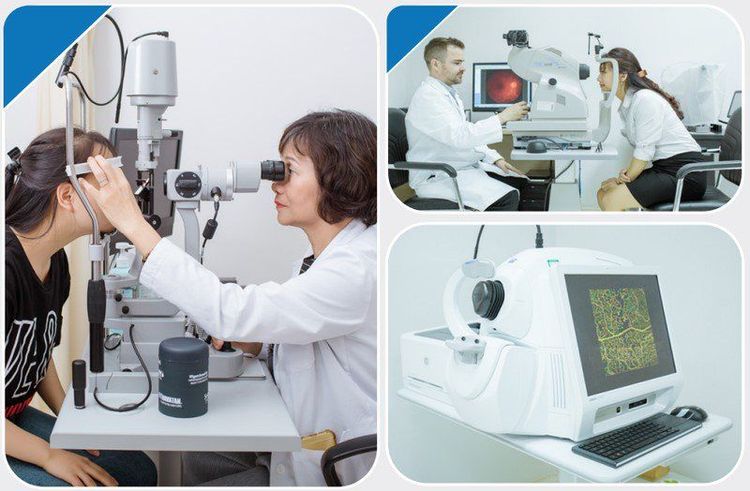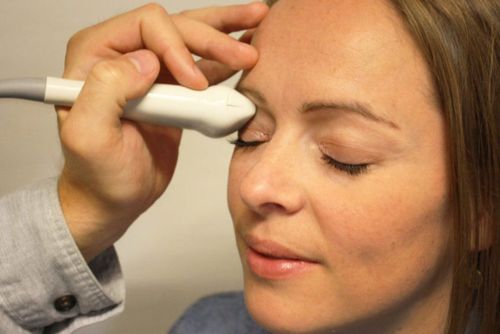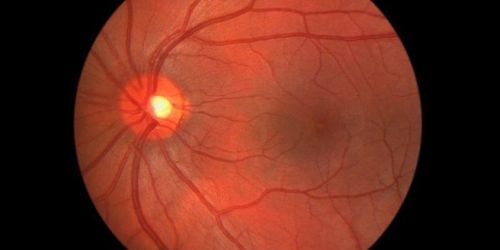This is an automatically translated article.
The article was professionally consulted with Specialist Doctor I Nguyen Thi Bich Nhi - Ophthalmologist - General Surgery Department - Vinmec Nha Trang International General Hospital.Microsurgery to suture the corneal surgical edge due to an injury is a very important first aid step to help close the wound and limit the risk of infection in the patient. The good treatment of the corneal scleral tear will create favorable conditions for the next steps of treatment and at the same time can limit the complications that occur to the eye when performing microsurgery to suture the corneal surgical edge.
1. What is the sclera? What is the cornea?
The sclera is the protective outer layer of the eye. The sclera is the white part of the eye. The sclera occupies 4/5 of the back of the eyeball, is made up of many layers of thick fibrous bandages that cross each other very firmly.The cornea is the black part. The cornea is a transparent, cone-shaped membrane that occupies the anterior fifth of the ocular cortex. The cornea is composed of 5 layers that protect the eyeball, control and focus light entering the eye.
Symptoms of corneal scleral tear:
The patient has clinical signs:
Eye pain Blurred vision When examined:
Appears wounds in the cornea, sclera Perform tests and prescribe eye ultrasound to detect retinal fluid damage: vitreous hemorrhage, retinal detachment.
2. Indications of microsurgery to suture the corneal surgical margin
The doctor will prescribe microsurgery to suture the corneal surgical edge when the patient has an injury that causes a tear in the cornea, sclera or sclera, and the two edges of the wound are open and not closed.This indication is not contraindicated for any patient, but in some cases: There is no absolute contraindication. Relative contraindications in the following cases:
Patient's eyes are completely lost function, severe eyeball rupture, very difficult conservative suture, risk of infection, high sympathetic inflammation. The general health condition does not allow surgery The doctor will consider and evaluate the general first.
3. Microsurgery to suture the corneal surgical edge

Bệnh nhân cần thực hiện các xét nghiệm ban đầu để đánh giá sức khỏe trước khi thực hiện vi phẫu khâu lại mép mổ giác mạc
Clinical tests:
The patient needs to perform initial tests to assess health before when performing microsurgery to suture the corneal margin
Full body examination: Heart, lungs, blood pressure, ENT. Laboratory tests: Complete blood count, blood sugar, bleeding, blood clot, blood group. Conditions: Chest X-ray, echocardiogram, electrocardiogram. Bacterial culture for antibiogram. Performers: Including ophthalmologists, technicians, nursing assistants.
Means of performing the microsurgery process to suture the corneal surgical margin
Surgical microscope. Microsurgery kit. Use 10-0 nylon needle only for corneal wounds, 9-0 nylon and 7/0 vicryl for scleral wounds. Performing anesthesia, local anesthesia:
For patients who are children and those with poor coordination ability, general anesthesia may be indicated for the corneal and scleral suturing process to take place. more advantageous. In addition, for patients with severe rupture of the eyeball, the doctor also prescribes general anesthesia to avoid further entrapment of intraocular tissues.
Carry out surgery to suture the corneal margin:
Fix 2 eyelids by placing 2 eyelid threads or using automatic eyelid rims to expose the eyeball. Clean the wound edge: remove secretions, dirty foreign objects clinging to the wound edge. Iris adhesion separation: use spatul to separate the adhesion between the iris and the wound edge, especially the posterior margin. Scleral wound requires conjunctival dissection, tenon covers the wound: Dissect the conjunctiva (both tenon and episcleral tissue) from front to back, both dissecting and exposing the wound. Dissect the conjunctiva to any place, suture the wound there to prevent further entrapment of intraocular tissue. Treatment of jammed organs: very limited excision Iris: In case the patient is detected early, the iris is clean and has not been necrotic, it is possible to push the iris back into the anterior chamber. In case the patient has been waiting for a long time, the iris has been necrotic until late, it will need to be removed.
Eyelashes: need to be very preserved. Only remove the ciliary body very sparingly when the ciliary body is necrotic and pus-filled. Cataract rupture: remove the stuck vitreous stick to the edge of the corneal tear. The remaining vitreous will be treated then 2. Vitreous: cut out the part of vitreous stuck outside the corneal tear edge. Minimize extra vitreous drainage. The trapped retina should be maximally preserved and pushed through the wound edge into the intraocular surface. Corneal suture:
Corneal tear at the margin is sutured with 9-10 nylon thread, central corneal tear is sutured with 10-0 nylon thread. Separate stitches or over stitches. The stitches go through 3/4 of the corneal thickness, the deeper the better. The distance between the two edges of the tear is equal (except for the case where the tear goes diagonally). Order of stitches: The wound goes through the margin, the first stitch will be placed at the edge of the sclera. The next stitches will be in the order of the cornea and then the sclera. Angle wound, the first stitch must be placed at the angled position. The next stitches will go in order from the top of the corner to the outside. The wound goes through the center, try not to place the stitches through the visual axis. When the wound edge is slightly edematous, suture about 1mm from both sides. When the wound is edematous, the sutures are further away from the edge. Reconstruct the anterior chamber with steam or ringer lactate solution. After reconstruction, the entire anterior chamber was either air bubbles or ringer lactate solution, with no adhesions between the iris, opacified vitreous material, or vitreous humor with the torn cornea. with 7-0 vicryl suture, the suture penetrates 80% of the thickness of the sclera. If the wound is located below the rectus muscle, a strabismus or a fixed stitch can be used to slightly raise the rectus muscle for suturing (it may be necessary to cut the rectus muscle in some cases and stitch it up after the wound is closed. sclera). When the scleral wound is posterior to the equator, suture the sclera as far as possible. Attempts to suture a scleral tear that opens too deeply posteriorly may increase the risk of intraocular tissue rupture and ejection hemorrhage. Pay attention not to jam or stick the iris, broken vitreous matter, vitreous fluid, and retinal choroid into the surgical edge. Cover the conjunctiva with 7-0 or 8-0 vicryl sutures. At the end of surgery, antibiotic injection is done under the conjunctiva or the side of the eyeball. Apply antibiotic ointment, atropin ointment and eye patch. At the end of the microsurgery technique, the patient was taken back to the room to rest so that the nurse could monitor the signs:
Is the wound edge swollen after stitching? Is the wound closed? See if there is entrapment or adhesion of intraocular tissues to the corneal suture edge? Room charge: deep, shallow or flat? The anterior chamber collapse may be caused by a surgical margin opening or by an enlarged or displaced cataract. Treat promptly if intraocular hemorrhage, uveitis, or infection occurs. Microsurgery to suture the corneal surgical edge when the cornea is torn, the sclera is a complicated technique, requiring carefulness and high skill of the doctor. Therefore, when seeing abnormal signs in the eyes such as the above-mentioned signs, it is necessary to go to reputable hospitals for timely examination and treatment, avoiding long-term danger to the eyes. Vinmec International General Hospital is one of the leading hospitals in Vietnam with international quality standards, a team of qualified and highly qualified medical doctors, nurses, and the most modern equipment system available today. Now can be a safe and reliable choice when going to the doctor.
Please dial HOTLINE for more information or register for an appointment HERE. Download MyVinmec app to make appointments faster and to manage your bookings easily.













